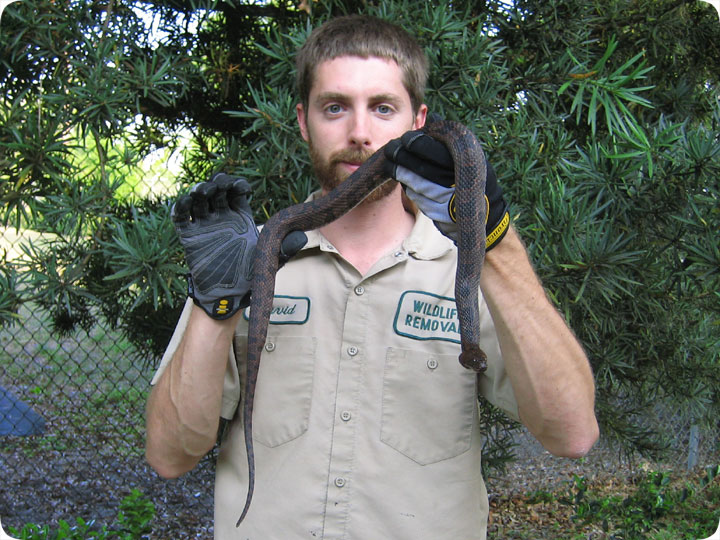-
info@aaanimalcontrol.com
Call us for help in your town
Humane Wildlife Education
Florida Water Snake

12.08.2007 - Here is a fine specimen of a Brown Water Snake, (Nerodia taxispilota). This snake is supposedly common in some areas, but I've found only a few during my time as a nuisance wildlife trapper here in Orlando Florida. This snake is, like
pretty much all aquatic snakes, heavy-bodied in comparison to most snakes. Part of the reason for the body shape is because of the buoyancy needed for waterbound critters. I'm surprised that these snakes don't have any sort of a paddle-tail, but they don't. They swim
just fine, moving along the surface of the water via peristaltic undulation.
I've read that this snake can reach six feet in length, but I doubt that. I suspect that this snake is above two standard deviations from the mean size for this species. When I say mean, I of
course mean (intend) average, not mean-spirited. It's not a mean-spirited snake at all. In fact, I don't believe that this snake possesses a spirit at all. This is in contrast to the Water
Moccasin, or Cottonmouth, which does have a spirit, an evil venom injecting one.
The Brown Water Snake is often mistaken for the venomous Cottonmouth, which is too bad, because it means unfair persecution. But then again, pretty much all snakes are subject to unfair persecution. But when you look very similar to one of the nastiest, bitey, snakes in
the lake, you're bound to receive a little more prejudice than the average serpent. Luckily for this fellow that I'm holding, I'm informed. I know that he's totally harmless, and that's why you see me holding him with such an air of calm nonchalance. So take a good look
at the above snake, and if you see one just like it during your next skinny dip in a Florida swamp, fear not. Give it a gentle pat on the back and send it on its merry way. Then look out for alligators and Cottonmouth.
Do it yourself: Visit my How To Get Rid of Snakes page for tips and advice.
Get professional help: Visit my Nationwide Pro Directory of wildlife removal experts.
For more wildlife stories, click my Wildlife Blog
or click my below banner to hire a local trapper.
You can also catch snakes with a special trap, which you can order by clicking this banner:

With such an abundance of swamps and marshland, much of Florida makes the ideal habitat for water snakes. Thankfully, most are non-venomous, one key exception though is the deadly water moccasin. While sometimes similar in appearance, water snakes and water moccasins are from two different families of snake: Colubrids and Vipers respectively.
Below are just a few of the several species of water snakes that Florida is home to.
Banded Water Snakes
Named for the bands that run across its back, the banded water snake has a thick body and grows between 24 – 60 inches long. Its base color can vary from gray to yellow, tan, or reddish, with cross bands that are black, brown, or red and often bordered with black.
One of Florida's most common water snakes, banded water snakes can be found in almost every freshwater habitat, except in the Keys. Found in most freshwater habitats, this non-venomous snake favors ponds, streams, lakes, rivers, and marshes. As a water snake, it's primary source of food also lives in the water and includes frogs, salamanders, fish, crayfish and tadpoles.
Florida Green Water Snakes
Growing between 30 and 74 inches long, the Florida green water snake isn't always green in color. Their thick bodies can range from greenish, brownish, and orangish, sometimes with small speckles or flecks of color on their scales. Because of their darker colors, they are sometimes mistaken for the water moccasin and killed needlessly: the Florida green is non-venomous.
They commonly make their habitats in calm waters, such as hyacinth-choked canals, lakes, ponds, marshes, prairies, and estuaries. Found everywhere in Florida except the Keys, their diet includes both amphibians and fish.
Brown Water Snakes
The brown water snake can be found throughout Florida, except in the Keys. Its habitat ranges from rivers, ponds, canals, lakes, cypress strands, sawgrass prairies, swamps, and flooded stands of melaleuca. A capable climber as well as a swimmer, the brown water snake can often be seen basking on tree limbs over the water.
Growing between 2.5 - 5 feet in length, they are a light tan color, with darker brown squares across the back that give them a checkerboard appearance. Their broad head and high-set eyes result in them commonly being confused for water moccasins, though the brown water snake is non-venomous.
Eastern Mud Snake
The eastern mud snake can be found in almost anywhere in Florida where there is freshwater, except the Keys. Its habitat ranges from rivers and lakes to cypress swamps and marshes, and even drainage ditches, preferring areas that have dense vegetation and muddy banks. As a water snake, it feeds primarily on other aquatic animals, such as salamanders, frogs, and sometimes fish.
Ranging in size between 40 – 81 inches long the eastern mud snake is glossy black, with a black and pink checkerboard belly. They are also harmless and incredibly docile creatures. The eastern mud snake doesn't bite when picked up; it just presses the end of its pointed tail against your hand to try and make you let go.
Regardless of whether you think a snake is venomous or not, it's never a good idea to get close or try to handle it yourself. Keep your distance from snakes, and if they are in an area close to people (such as near your home) call a professional to remove it safely.




















